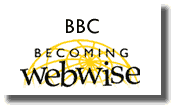
BBC
Becoming WebWise!
Learning
Objectives
Assessment Criteria
- Identify
current Internet enabled devices
- Identify
the current range of Internet enabled devices.
- Identify
from a list the current range of Internet and email enabled devices
(personal computers; digital television; mobile communication
devices; games consoles).
- Know key
Internet related terms and phrases.
- Identify
key Internet related terms and phrases that relate to personal
computer, digital television, mobile communication devices, games
console.
- Show awareness
of Internet enabled devices and their basic functions
- Understand
the current limitations of Internet enabled devices for the user
(in terms of speed of access/connection, range of available content,
viewability/readability, data storage and cost).
- Identify
benefits and drawbacks of using each of the following technologies
for Internet access: personal computers, digital television, mobile
communication devices, games consoles.
- Understand
the main features of interactive digital television and its benefits
to the viewer.
Identify the main features of digital television (multi-channel
access, picture and sound quality, access to the Internet, email
and interactive services).
- Know current
types of digital television services.
- Identify
the current modes of digital television transmission (terrestrial,
satellite and cable).
- Understand
the basic functions of Internet enabled mobile communication devices.
- Identify
the differences between mobile communication devices and Internet
enabled mobile communication devices.
- Know the
hardware and software elements required for an Internet connected
PC.
- Identify
components required (modem, hard disk space; email and browser
software, telephone line, ISP software for dial-up/network access).
- Understand
basic Internet concepts and its main tools
- Understand
the organisation of the Internet and its main services.
- Identify
Internet based services (World Wide Web, email, newsgroups/chat)
and how the
- Internet
is organised (network of networks, global nature, client/server).
- Understand
the mechanisms/processes required to connect to the Internet.
- Identify
ways of connecting to the Internet and how Internet access is
provided (modem or networks/ISDN and role of ISP).
- Recognise
the use of multi-media applications (sound, animation, video)
on-line.
- Locate websites
that use multi-media applications (e.g. sound, animation, video)
and identify their associated application/plug-in.
- Use the basic
functions of a web browser and search for information
- Enter and
save a web address and show a basic understanding of World Wide
Web addresses.
- Enter specified
web addresses, and save and recall web addresses, using favourites/bookmarks.
- Navigate
the World Wide Web using a web browser.
- Operate a
web browser, using key buttons/functions and follow hyperlinks
to achieve specified purposes.
- Find information
on the World Wide Web, and show a basic understanding of the functions
of search engines.
- Execute simple
searches as specified, including use of search engines functions,
and select required information.
- Use the basic
functions of an email package
- Understand
how email works.
- Identify
the main stages of the mail delivery process in simple terms.
- Create, send
and reply to email messages, including attachments.
- Construct
and send email messages as specified; receive and respond to emails,
including attachments.
- Use basic
mail management facilities.
- Add email
addresses to an address book; send email messages using an address
stored in an address book; store/file received messages.
- Apply the
Internet to potential personal uses
- Recognise
how on-line services differ depending on access platforms/devices.
- Identify
pros and cons of accessing the Internet via PC, games console,
digital TV and mobile communication devices.
- Understand
potential uses of the Internet.
- Identify
examples of use of the Internet for specific groups (e.g. teacher,
business, home/entertainment, education) and for particular purposes
(e.g. e-commerce, e-learning, e-browsing).
- Outline
health and safety and security issues relevant to the Internet
- Identify
key Internet safety issues.
- Identify
dangers of viruses and how to protect against them (e.g. using
virus protection software); identify access control/content filter
functions (e.g. content filtering in browser, secure access sites,
parental control options).
- Understand
main data protection legislation and copyright issues relevant
to using the Internet.
- Identify
key aspects of data protection laws and Internet copyright laws.
- Show due
regard for health and safety whilst operating a computer.
- Identify
aspects of good practice in operating an Internet enabled device
showing regard to body posture, potential eye strain and positioning
of screen.
For more information
try the BBC Webwise homepage
Critical Skills (UK) LTD
Tapton Park Innovation Centre
Brimington Road
Chesterfield
Derbyshire
S41 0TZ
Tel : +44 (0) 1246 557 873
Fax : +44 (0) 1246 230 055
information@critical-skills.co.uk
|



